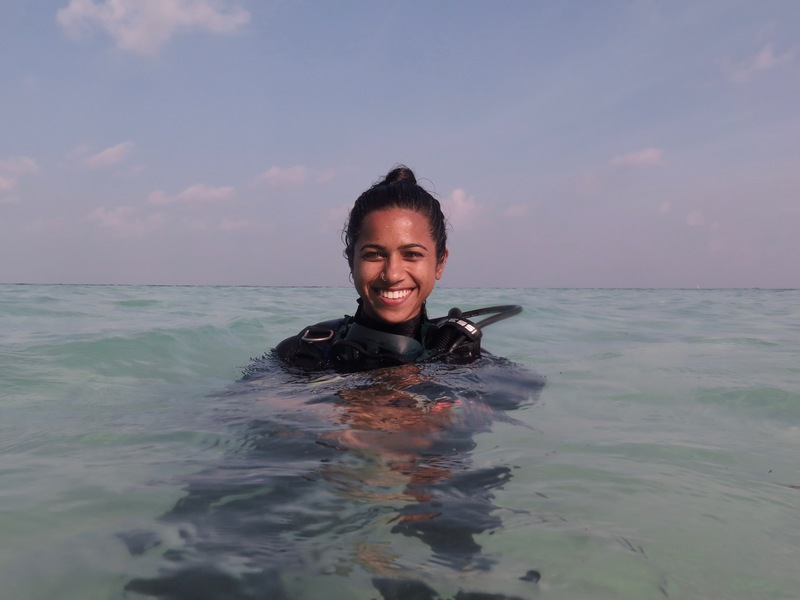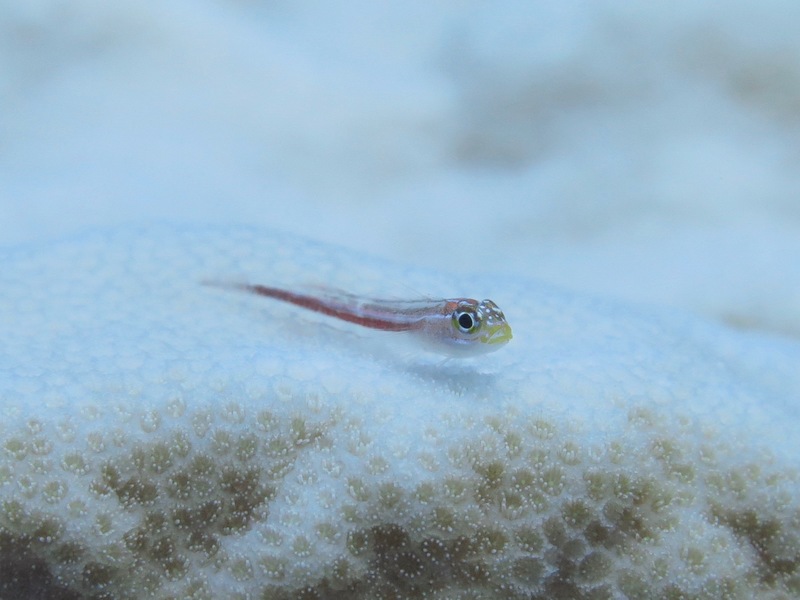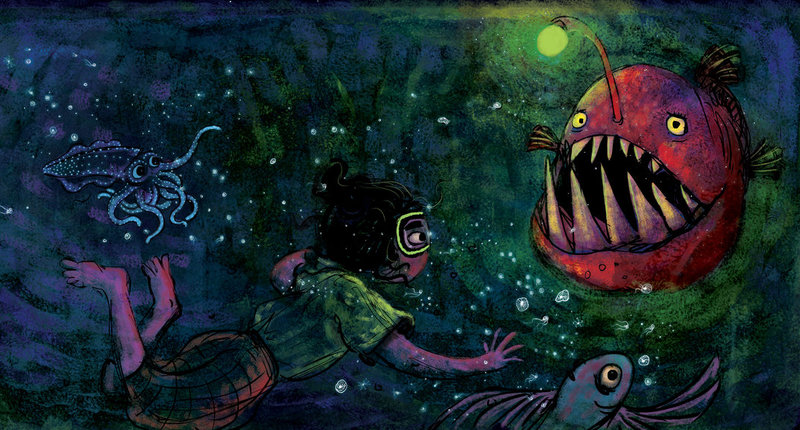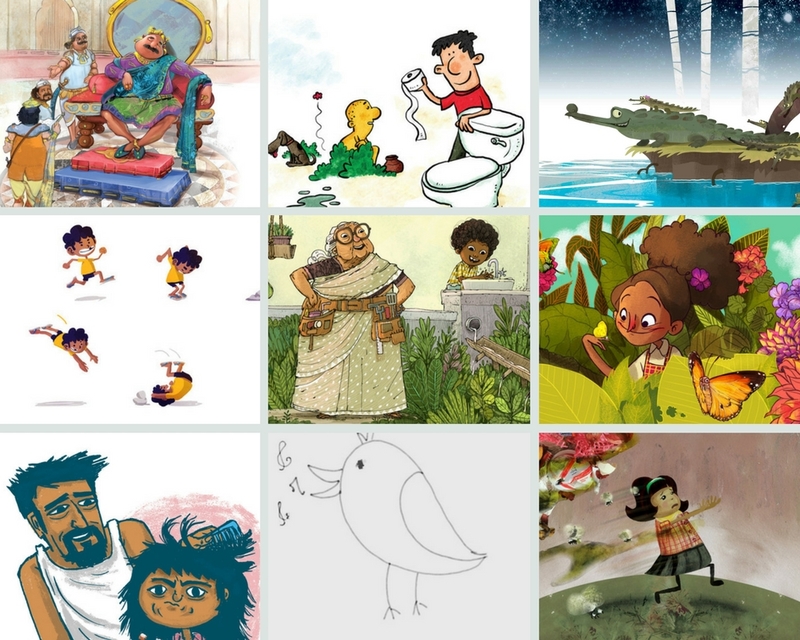Author Interview: Marine Biologist Shreya Yadav on writing her first picture book and spying on underwater creatures
Posted by Yamini Vijayan on January 04, 2019In The Night the Moon Went Missing, written by Shreya Yadav and illustrated by Sunaina Coelho, a young girl sets out on a grand adventure to find her missing friend. Shreya is a marine biologist who studies coral reefs. One of her favourite things to do is cling onto a rock underwater and spy on all the fish and plants and crabs and coral that live there.
In this short interview, Zeba Imtiaz, assistant editor at Pratham Books, talks to Shreya about life under water, her favourite children's books and the process of writing The Night the Moon Went Missing, a truly enchanting picture book.
Excerpts from the interview:
How did your interest in the ocean and creatures in the ocean begin?
Growing up in Madras, the Bay was always quite central to our lives. My brother and I would trot off to the beach every other day after school and spend hours in the water. We lived very close by - there was always a sliver of the ocean visible from our balcony - so I think we took the salt and sand for granted. I started diving when I was 19 on a family holiday to the Andaman islands. My father, who SCUBA dives, asked if I wanted to do my beginner course at Havelock island. I remember seeing an octopus and an eel and all kinds of other impossibly bizarre life on my first dive and being totally blown away. Even though I was studying zoology at the time, that was the first time I really wondered about the ecology of a coral reef without it being some kind of abstract concept.

If you had to pick, which would be your favourite ocean creature, and why?
I definitely have a thing for the small and cryptic critters that live on a reef. Often, I will be swimming over something, and will catch a tiny eye peering at me from behind something. I always wonder what their lives are like. Blennies and gobies are probably my favourites.

What sort of books did you read as a child? What was your favourite book growing up?
I was lucky to grow up with great books and a family that enjoyed dramatic readings of them! I remember being obsessed with Ekki-Dokki (Sandhya Rao; Tulika) when I was very little and then by a book called Trash! (Anushka Ravishankar and Gita Wolf; Tara Books) when I was a bit older. I also read a lot of Roald Dahl. I think I found Quentin Blake's illustrations very weird as a kid, but there was something so different about them that it was hard to put down.
What was your writing process for your book The Night the Moon Went Missing?
I think we had discussed that bioluminescence would be an interesting topic to explore for this book, but the story actually took a while to come. I knew I wanted it to be taking place on an island and I had a list of creatures I thought were interesting in terms of their biology, but I didn't know how to make it all come together. I think it finally came to me after a few conversations on the phone with friends - saying things out loud always helps.
Later, when I read the first draft out to my parents, my mother told me it reminded her of a story my great-grandmother had written for children which also involved the moon and three young girls on a nighttime adventure. As soon as she said it I remembered that book. Now I feel like I subconsciously plagiarized my great-grandmother!
What was you favourite part of writing this story? What was the most challenging bit?
I had so much fun writing this. I think the most challenging bit was trying to stick to the word limit - I was worried that it would be hard to visualize in so few words, since it was all taking place underwater at night with a bunch of strange glowing animals. But Sunaina's beautiful illustrations more than took care of that. I think my favourite thing about the book now are her illustrations.

If you were to write another children's book, what would it be about?
I think it would be fun to profile a bunch of marine critters in limerick form, Ogden Nash style.
Do you think your childhood was different from how children live today?
I'm not sure - I have a feeling everyone who is asked this question will probably say yes. I remember having a lot of time in the day to play and climb trees and run around the beach and I hope that that is still the case today.
Who are some of the authors you enjoy reading today?
Big fan of Italo Calvino, Jorge Luis Borges, Loren Eisley, Peter Godfrey-Smith, Robert Macfarlane, WS Merwin.
Any favourite illustrators?
Closer to home, I really like the work of Sonali Zohra, Renuka Rajiv, Vinayak Varma, Orijit Sen, Sarnath Banerjee and the geniuses behind Crocodile in Water, Tiger on land - whoever they are.
Have you read The Night the Moon Went Missing? It is available on StoryWeaver for free, in English, Kannada, Marathi, Tamil and Hindi, and will soon be available in print.
Be the first to comment.Wider Net: Providing access to educational resources
Posted by Remya Padmadas on July 05, 2016The WiderNet Project is a non-profit organization affiliated with the University of North Carolina, Chapel Hill that promotes low-cost information and communication for underserved populations.
The eGranary Digital Library, also known as "The Internet in a Box", is an off-line information repository that delivers over 32 million educational resources to people living in underserved areas of the world. The eGranary Digital Library delivers digital information directly to Web servers inside subscriber institutions, bypassing bandwidth problems. Many subscriber institutions have no internet access or an internet connection experience that is slow, unreliable and very expensive. With the eGranary Digital Library, thousands of people can access the information over their local area networks quickly and at no cost.
The eGranary is already installed at over 1,200 universities, schools, health care centers, and libraries worldwide. They have a huge presence in Africa and India, and in India, they work with a number of organizations, including Samarthanam Trust for the Disabled, Karnataka, Tibetan Children's Village, Himachal Pradesh, AKSHAYA Rehabilitation Trust, Tamil Nadu, Association for Rural Development and Action Research, Vizianagaram and Andhra Pradesh, Blind Peoples Association, Gujarat, India.
Laura Ashcraft, a Digital Librarian at The Wider Net Project, generously took the time to answer some questions for us about the project.
Q: How do you find potential content providers?
Usually what I do is add and organize content for a set of domains (think special libraries) that I manage. I am either actively looking through the Internet or databases, or I stumble across a viable candidate whilst looking for something else. The key is keeping the projects organized. Much of what we seek is inspired by requests we get from subscribers and users.
Q: Do you have any criteria by which you screen content that is shared on the eDigitalGranary? Who does this screening?
Of course, it goes without saying: no pornography, nothing demeaning or incendiary. On top of this:
· Educational (content must add to a user’s knowledge and/or skill level)
· Domain specific (creating a special library, what we call portals)
· Reliable (the source is vetted as either being produced by a professional or the content is well researched)
· Trustworthy (the content is produced by organizations or individuals who stand by their work.)
For example, StoryWeaver presents not only a wide variety of children’s stories, but the stories themselves do not intentionally portray any culture in a negative light. And of course, I always ask myself does this content serve our community in the most beneficial way?
The content is screened by the librarians here at the WiderNet. If we have a question (content too provocative, is there a broader bias which makes us uneasy, might there be another site that has similar content, etc.?), we consult with our librarian colleagues at UNC or professionals in the respective fields.
Q: Do you customise content on the digital eGranary based on the organisation (school, college etc.) or based on geographical location?
We customize content as per organization request. Not by limiting or subtraction, but by highlighting information that meets a particular group’s needs. This usually means we create a portal and organize existing content within the eGranary around those specific categories. We also actively acquire new content from site providers. Sometimes our volunteer librarians express an interest in a subject we have not explored and they build a portal based on this interest.
Q: Do you have a system by which you can track the number of reads/downloads etc of content on a digital granary? Do you ever look at or analyse this data?
Occasionally we get Apache server logs from our subscribers. We then learn about “hits” (how many times a page is visited or a document downloaded.) Given that most of our subscribers don’t have an Internet connection, this can get awkward.
Q: How often is content on a digital eGranary box updated to keep it relevant?
About twice a year we update the collection that goes out the door. Some organizations purchase an updated drive every couple years, others run the drive until they die. (The medical school in Liberia had theirs up for nine years!) However, subscribers can update the collection by adding their own content on-the-fly.
WiderNet’s latest project is the Pocket Library project. These are chip-sized libraries for specific populations. An Ebola Pocket Library the organisation created in 2015 made them realized the potential application of the "library on a chip" concept.
Q: The Pocket Library sounds like an amazing idea. Could you share details about its progress?
The last pocket library we built was called Girls Can Code – Ethiopia. With the help of our colleagues in Durham NC and Ethiopia we developed a curriculum to teach 40 high school teenage girls about ICT, from building a physical computer, understanding Windows and software application, creating their websites, and finally programming. The librarians’ job was to help develop the curriculum, acquire the resources both in the eGranary and without, and build a website for the project. We had technical staff work on the scraping and troubleshooting and all the other myriad things that must be done to get the content to work as it does on the live internet. This is no small job, but it is incredibly satisfying to know that these USBs are going to be used and kept as a resource for continued education and growth. You can read about that here and here.
WiderNet is in the process of ‘scraping’ the StoryWeaver site to include on their eGranaries. ‘Scraping’ is the process of essentially copying a site. The trick is to get all the functions to work offline as they do online.
Watch this space for updates about StoryWeaver on eGranaries. You can follow Wider Net on Twitter @WiderNetProject
Be the first to comment.Top Reads of 2017!
Posted by Remya Padmadas on December 26, 2017